Ultrasonic-Assisted Hot-Press Sintering: A Novel Method to Reduce the Densification Temperature and Enhance the Mechanical and Tribological Properties of Cu–Graphite Composites
Abstract
1. Introduction
2. Materials and Methods
3. Results
3.1. Phase Composition and Micromorphology of Raw Materials
3.2. Phase Composition and Microstructure of Bulk Cu–GraphiteComposites
3.3. Electrical Conductivity of Cu–Graphite Composites
3.4. Mechanical Properties of Cu–Graphite Composites
3.4.1. Hardness
3.4.2. Flexural Strength
3.5. Friction and Wear Behaviors
3.5.1. Friction Coefficient of Cu–Graphite Composites
3.5.2. Wear Properties of Cu–Graphite Composites
4. Discussion
4.1. Densification-Temperature Reduction Mechanisms by UAHP
4.2. Mechanisms Underpinning the Mechanical Properties
4.3. Mechanism for Low Friction Coefficient and Wear Rate
5. Conclusions
- Using the two-stage ultrasonic-assisted hot-press sintering technique, dense Cu–graphite composites with aligned graphite flakes were fabricated at 700 °C in 10 min, achieving at least a 160 °C reduction in sintering temperature.
- The yield strength of Cu–graphite composites exhibits a two-stage evolution: at 0–15 vol.% graphite, it gradually decreases from 250 MPa to 232 MPa (7.2% reduction); at 20–30 vol.% graphite, the yield strength declines from 142 MPa to 133 MPa (6.3% reduction). The hardness of the composites decreases from 66.43 HV to 39.13 HV with the addition of graphite from 0 to 30 vol.%, while the electrical conductivity of the composites decreases from 41.4 × 106 S/m to 5.0 × 106 S/m.
- At a graphite volume fraction beyond 15%, the average friction coefficient of Cu–graphite composites approaches that of the dynamic coefficient of friction of graphite. In addition, the wear rate decreases significantly from 4.05 × 10−5 to 1.31 × 10−5 mm3·N−1·m−1 as the graphite content increases from 0 to 20 vol.%.
- The densification mechanism in ultrasonic-assisted hot-press sintering operates through two distinct stages. At the room-temperature stage, ultrasonic vibration induces acoustic softening, generating high-speed plastic deformation on particle surfaces that allows for efficient contacting and packing of the powders. At the high-temperature sintering stage, ultrasound reduces the sintering activation energy, simultaneously enhancing elemental diffusion.
Author Contributions
Funding
Acknowledgments
Conflicts of Interest
References
- Kaczmar, J.W.; Pietrzak, K.; Włosiński, W. The production and application of metal matrix composite materials. J. Mater. Process. Technol. 2000, 106, 58–67. [Google Scholar] [CrossRef]
- Mazloum, A.; Kováčik, J.; Emmer, Š.; Sevostianov, I. Copper–graphite composites: Thermal expansion, thermal and electrical conductivities, and cross-property connections. J. Mater. Sci. 2016, 51, 7977–7990. [Google Scholar] [CrossRef]
- Zhao, X.G.; He, G.Q.; Fu, P. Research on attrition loss of copper-graphite alloy material. Met. Funct. Mater. 2011, 18, 42–46. [Google Scholar] [CrossRef]
- Zhang, G.X. Effects of copper-coated graphite content and particle size on properties of the Cu/copper-coated graphite composite. Power Met. Technol. 2016, 34, 196–198. [Google Scholar] [CrossRef]
- Li, K.Q.; Xiang, X.Z.; Bai, X.J.; Liang, B.Y.; Gong, W.Y. Effects of particle size and copper-coated graphite content on properties of the Cu/copper-coated graphite composite. Met. Funct. Mater. 2016, 23, 47–50. [Google Scholar] [CrossRef]
- Varol, T.; Canakci, A. The effect of flake microstructure on the preparation and properties of Cu-graphite sintered nanocomposites. Powder Metall. Met. Ceram. 2016, 55, 426–436. [Google Scholar] [CrossRef]
- Zhu, L.Y.; Yi, M.Z.; Ge, Y.C.; Zhang, B.; Xie, A.L. Intuitive analysis of the microtribological behavior of copper-coated graphite–graphite/Cu composites with high graphite contents. ACS Omega 2022, 7, 28217–28225. [Google Scholar] [CrossRef]
- Moustafa, S.F.; El-Badry, S.A.; Sanad, A.M.; Kieback, B. Friction and wear of copper–graphite composites made with Cu-coated and uncoated graphite powders. Wear 2002, 253, 699–710. [Google Scholar] [CrossRef]
- Kováčik, J.; Emmer, Š.; Bielek, J.; Keleši, L. Effect of composition on friction coefficient of Cu–graphite composites. Wear 2008, 265, 417–421. [Google Scholar] [CrossRef]
- Nayak, D.; Debata, M. Effect of composition and milling time on mechanical and wear performance of copper–graphite composites processed by powder metallurgy route. Powder Metall. 2014, 57, 265–273. [Google Scholar] [CrossRef]
- Pokryshev, V.R.; Marchenko, V.I. Effect of ultrasound oscillationson the consolidationof iron powder in hot pressing. Powder Metall. Met. Ceram. 1969, 8, 110–112. [Google Scholar] [CrossRef]
- Abedini, R.; Abdullah, A.; Alizadeh, Y. Ultrasonic hot powder compaction of Ti-6Al-4V. Ultrason. Sonochem. 2017, 37, 640–647. [Google Scholar] [CrossRef] [PubMed]
- Singh, G.; Pandey, P.M. Rapid manufacturing of copper components using 3D printing and ultrasonic assisted pressureless sintering: Experimental investigations and processoptimization. J. Manuf. Process. 2019, 43, 253–269. [Google Scholar] [CrossRef]
- Singh, G.; Pandey, P.M. Design and analysis of long-stepped horn for ultrasonic-assisted sintering. Adv. Mater. Process. Technol. 2020, 7, 216–226. [Google Scholar] [CrossRef]
- Kumar, A.; Pandey, P.M. Effect of ultrasonic assisted sintering on mechanical properties and degradation behaviour of Mg15Nb3Zn1Ca biomaterial. J. Magnes. Alloys 2021, 9, 1989–2008. [Google Scholar] [CrossRef]
- Liu, Z.Y.; Ge, Y.; Zhao, D.D.; Lou, Y.; Liu, Y.; Wu, Y.; Yu, P.; Yu, C.Y. Ultrasonic assisted sintering using heat converted from mechanical energy. Metals 2020, 10, 971. [Google Scholar] [CrossRef]
- Chen, P.; Liao, W.B.; Liu, L.H.; Luo, F.; Wu, X.Y.; Li, P.J.; Yang, C.; Yan, M.; Liu, Y.; Zhang, L.C.; et al. Ultrafast consolidation of bulk nanocrystalline titanium alloy through ultrasonic vibration. Sci. Rep. 2018, 8, 801. [Google Scholar] [CrossRef]
- Wang, F.L.; Nie, N.T.; He, H.; Tang, Z.K.; Chen, Z.X.; Zhu, W.H. Ultrasonic-assisted sintering of silver nanoparticles for flexible electronics. J. Phys. Chem. C 2017, 121, 28515–28519. [Google Scholar] [CrossRef]
- Yan, Y.F.; Kou, S.Q.; Yang, H.Y.; Shu, S.L.; Qiu, F.; Jiang, Q.C.; Zhang, L.C. Ceramic particles reinforced copper matrix composites manufactured by advanced powder metallurgy: Preparation, performance, and mechanisms. Int. J. Extrem. Manuf. 2023, 5, 032006. [Google Scholar] [CrossRef]
- Zeng, F.K.; Ma, H.B.; Jiang, N.; Xue, C. Preparation and thermophysical properties of aligned graphite flake/Cu composites. Acta Mater. Compos. Sin. 2020, 37, 1951–1959. [Google Scholar] [CrossRef]
- Mortensen, A.; Llorca, J. Metal Matrix composites. Annu. Rev. Mater. Res. 2010, 40, 243–270. [Google Scholar] [CrossRef]
- Chawla, N.; Shen, Y.L. Mechanical behavior of particle reinforced metal matrix composites. Adv. Eng. Mater. 2001, 3, 357–370. [Google Scholar] [CrossRef]
- Li, H.Q.; Liu, Y.Z.; Zheng, B.C.; Wang, S.; Yi, Y.L.; Zhang, Y.Z.; Li, W. On the tribological behaviors of Cu matrix composites with different Cu-coated graphite content. J. Mater. Res. Technol. 2023, 25, 83–94. [Google Scholar] [CrossRef]
- Zhu, X.; Chen, R.S.; Zhu, X.F.; Li, Z.; Xu, G.F.; Jia, Y.L.; Zhang, Y.H. Microstructure, and physical and mechanical properties of copper–graphite composites obtained by in situ reaction method. J. Mater. Eng. Perf. 2020, 29, 1696–1705. [Google Scholar] [CrossRef]
- Archard, J.F. Contact and rubbing of flat surfaces. J. Appl. Phys. 1953, 24, 981–988. [Google Scholar] [CrossRef]
- Hashin, Z.; Shtrikman, S. A variational approach to the theory of the elastic behaviour of multiphase materials. J. Mech. Phys. Solids 1963, 11, 127–140. [Google Scholar] [CrossRef]
- Lassnig, A.; Zak, S. Precise determination of Young’s modulus of amorphous CuZr/nanocrystalline Cu multilayer via nanoindentation. J. Mater. Res. 2023, 38, 3324–3335. [Google Scholar] [CrossRef]
- Marques, V.M.F.; Johnston, C.; Grant, P.S. Nanomechanical characterization of Sn–Ag–Cu/Cu joints—Part 1: Young’s modulus, hardness and deformation mechanisms as a function of temperature. Acta Mater. 2013, 61, 2460–2470. [Google Scholar] [CrossRef]
- Cho, J.; Luo, J.J.; Daniel, I.M. Mechanical characterization of graphite/epoxy nanocomposites by multi-scale analysis. Compos. Sci. Technol. 2007, 67, 2399–2407. [Google Scholar] [CrossRef]
- Komatsu, K. Interpretation of the specific heat of various graphites at very low temperatures. J. Phys. Chem. Solids 1964, 25, 707–712. [Google Scholar] [CrossRef]
- Riley, D.P. The thermal expansion of graphite: Part II. Theoretical. Proc. Phys. Soc. 1945, 57, 486–495. [Google Scholar] [CrossRef]
- GB/T 33362-2016; Metallic Materials-Conversion of Hardness Values. Standards Press of China: Beijing, China, 2016.
- Su, Y.M.; Jiang, F.; Xiao, Z.Y.; Wu, F.F.; Long, M.J. Microstructure and tribological properties of copper/graphite composites with Ti3AlC2 addition prepared by rapid hot press sintering. Tribol. Int. 2024, 194, 109537. [Google Scholar] [CrossRef]
- Savage, R.H. Graphite lubrication. J. Appl. Phys. 1948, 19, 1–10. [Google Scholar] [CrossRef]
- Arnell, R.D.; Teer, D.G. Lattice parameters of graphite in relation to friction and wear. Nature 1968, 218, 1155–1156. [Google Scholar] [CrossRef]
- Li, B.B.; Wang, W.D.; Wang, F.; Li, Y. Friction and wear performance of graphite/SA533GrB steel end surface. Hot Work. Tech. 2024, 53, 111–115. [Google Scholar] [CrossRef]
- Han, Q.Y. Ultrasonic Processing of Materials. Metall Mater Trans B. 2015, 46, 1603–1614. [Google Scholar] [CrossRef]
- Blaha, F.; Langenecker, B. Dehnung von zink-kristallenunterultraschalleinwirkung. Natur. Wiss. 1955, 42, 556. [Google Scholar] [CrossRef]
- Blaha, F.; Langenecker, B. Untersuchungenzurbearbeitungserholung (verformungsentfestigung) von metallkristallen. Int. J. Mater. Res. 1958, 49, 357–360. [Google Scholar] [CrossRef]
- Blaha, F.; Langenecker, B. Plastizitätsuntersuchungen von metallkristallen in ultraschallfeld. Acta Metall. 1959, 7, 93–100. [Google Scholar] [CrossRef]
- Daud, Y.; Lucas, M.; Huang, Z.H. Ultrasonic compression tests on aluminium. Appl. Mech. Mater. 2006, 3–4, 99–104. [Google Scholar] [CrossRef]
- Daud, Y.; Lucas, M.; Huang, Z.H. Superimposed ultrasonic oscillations in compression tests of aluminium. Ultrasonics 2006, 44, 511–515. [Google Scholar] [CrossRef]
- Blaha, F.; Langenecker, B.; Oelschlägel, D. Zum plastischenverhalten von metallenunterschalleinwirkung. Int. J. Mater. Res. 1960, 51, 636–638. [Google Scholar] [CrossRef]
- Huang, H.; Pequegnat, A.; Chang, B.H.; Mayer, M.; Du, D.; Zhou, Y.; Daud, Y.; Lucas, M.; Huang, Z.H. Influence of superimposed ultrasound on deformability of Cu. J. Appl. Phys. 2009, 106, 113514. [Google Scholar] [CrossRef]
- Huang, H.; Chang, B.H.; Du, D. Effect of superimposed ultrasound on mechanical properties of copper. Mater. Sci. Technol. 2011, 27, 1117–1122. [Google Scholar] [CrossRef]
- James, S.; Rajanna, P. Molecular dynamics simulation study of ultrasonic powder consolidation process. In Proceedings of the ASME 2018 13th International Manufacturing Science and Engineering Conference, College Station, TX, USA, 18–22 June 2018; ASME: New York, NY, USA, 2018; Volume 4, p. V004T03A026. [Google Scholar] [CrossRef]
- Li, X.Q.; Hu, L.X.; Wang, E.D.; He, W.X.; Liu, Z.Y. Microstructure of TiAl alloy prepared by intense plastic deformation and subsequent reaction sintering. Trans. Nonferrous. Met. Soc. China 2002, 12, 621–624. [Google Scholar]
- Lee, C.G.; Wei, X.D.; Kysar, J.W.; Hone, J. Measurement of the elastic properties and intrinsic strength of monolayer graphene. Science 2008, 321, 385–388. [Google Scholar] [CrossRef]
- Zhao, W.D.; Liu, D.X.; Qin, H.F.; Zhang, X.H.; Zhang, H.; Zhang, R.X.; Ren, Z.C.; Ma, C.; Amanov, A.; Pyun, Y.-S.; et al. The effect of ultrasonic nanocrystal surface modification on low temperature nitriding of ultra-high strength steel. Surf. Coat. Technol. 2019, 375, 205–214. [Google Scholar] [CrossRef]
- Preeyanghaa, M.; Vinesh, V.; Sabarikirishwaran, P.; Rajkamal, A.; Ashokkumar, M.; Neppolian, B. Investigating the role of ultrasound in improving the photocatalytic ability of CQD decorated boron-doped g-C3N4 for tetracycline degradation and first-principles study of nitrogen-vacancy formation. Carbon 2022, 192, 405–417. [Google Scholar] [CrossRef]
- Xiong, Z.L.; Zhang, Y.F.; Chen, D.Y.; Zhang, Y. Effect of welding energy on interdiffusion behavior of interfacial elements in Cu/Al joints welded by ultrasonic welding. Hot Work. Technol. 2021, 50, 118–121. [Google Scholar] [CrossRef]
- Cui, Y.; Xu, C.L.; Han, Q. Effect of ultrasonic vibration on unmixed zone formation. Scr. Mater. 2006, 55, 975–978. [Google Scholar] [CrossRef]
- Gallego-Jua’rez, J.A.; Graff, K.F. Power Ultrasonics Applications of High-Intensity Ultrasound, 1st ed.; Woodhead Publishing: Cambridge, UK, 2015; pp. 259–292. [Google Scholar]
- Liao, S.; Zhang, H.; Jia, B.; Wu, H.M.; Di, Y.J.; Wan, X.; Liu, B. Ultrasound-assisted conventional sintering of silicate ceramics. Ceram.–Silikáty 2022, 66, 571–578. [Google Scholar] [CrossRef]
- Khasanov, O.L.; Dvilis, E.S. Net shaping nanopowders with powerful ultrasonic action and methods of density distribution control. Adv. Appl. Ceram. 2008, 107, 135–141. [Google Scholar] [CrossRef]
- Zhou, Q.; Song, S.T.; Chen, Q.F.; Bai, Y.L. Comprehensive studies on hot compaction and vibration-assisted compaction tests of aluminum powder. ASME J. Manuf. Sci. Eng. 2021, 143, 011006. [Google Scholar] [CrossRef]
- Li, Q.; Wu, Z.C.; Zhou, L.M. Study on plastic deformation mechanism of GNSs/Mgcomposites from GNSs orientation angle. Hot Work. Technol. 2025, 54, 74–81+88. [Google Scholar] [CrossRef]
- Blyth, R.I.R.; Buqa, H.; Netzer, F.P.; Ramsey, M.G.; Besenhard, J.O.; Golob, P.; Winter, M. XPS studies of graphite electrode materials for lithium ion batteries. Appl. Surf. Sci. 2000, 167, 99–106. [Google Scholar] [CrossRef]
- Poulston, S.; Parlett, P.M.; Stone, P.; Bowker, M. Surface oxidation and reduction of CuO and Cu2O studied using XPS and XAES. Surf. Interface Anal. 1996, 24, 811–820. [Google Scholar] [CrossRef]
- Xie, Y.; Sherwood, P.M.A. X-ray photoelectron-spectroscopic studies of carbon fiber surfaces. Part XII: The effect of microwave plasma treatment on pitch-based carbon fiber surfaces. Appl. Spectrosc. 1990, 44, 797–803. [Google Scholar] [CrossRef]
- Lakshmikanthan, A.; Angadi, S.; Malik, V.; Saxena, K.K.; Prakash, C.; Dixit, S.; Mohammed, K.A. Mechanical and Tribological Properties of Aluminum-Based Metal-Matrix Composites. Materials 2022, 15, 6111. [Google Scholar] [CrossRef]
- Ujah, C.O.; Kallon, D.V.V.; Aigbodion, V.S. Tribological Properties of CNTs-Reinforced Nano Composite Materials. Lubricants 2023, 11, 95. [Google Scholar] [CrossRef]
- Chen, W.Y.; Tan, H.; Cheng, J.; Zhu, S.Y.; Yang, J. Research Progress and Prospect of Tribological Properties of Cold Sprayed Copper-based Composite Coatings. Mater. Rep. 2022, 36, 21080083-7. [Google Scholar] [CrossRef]
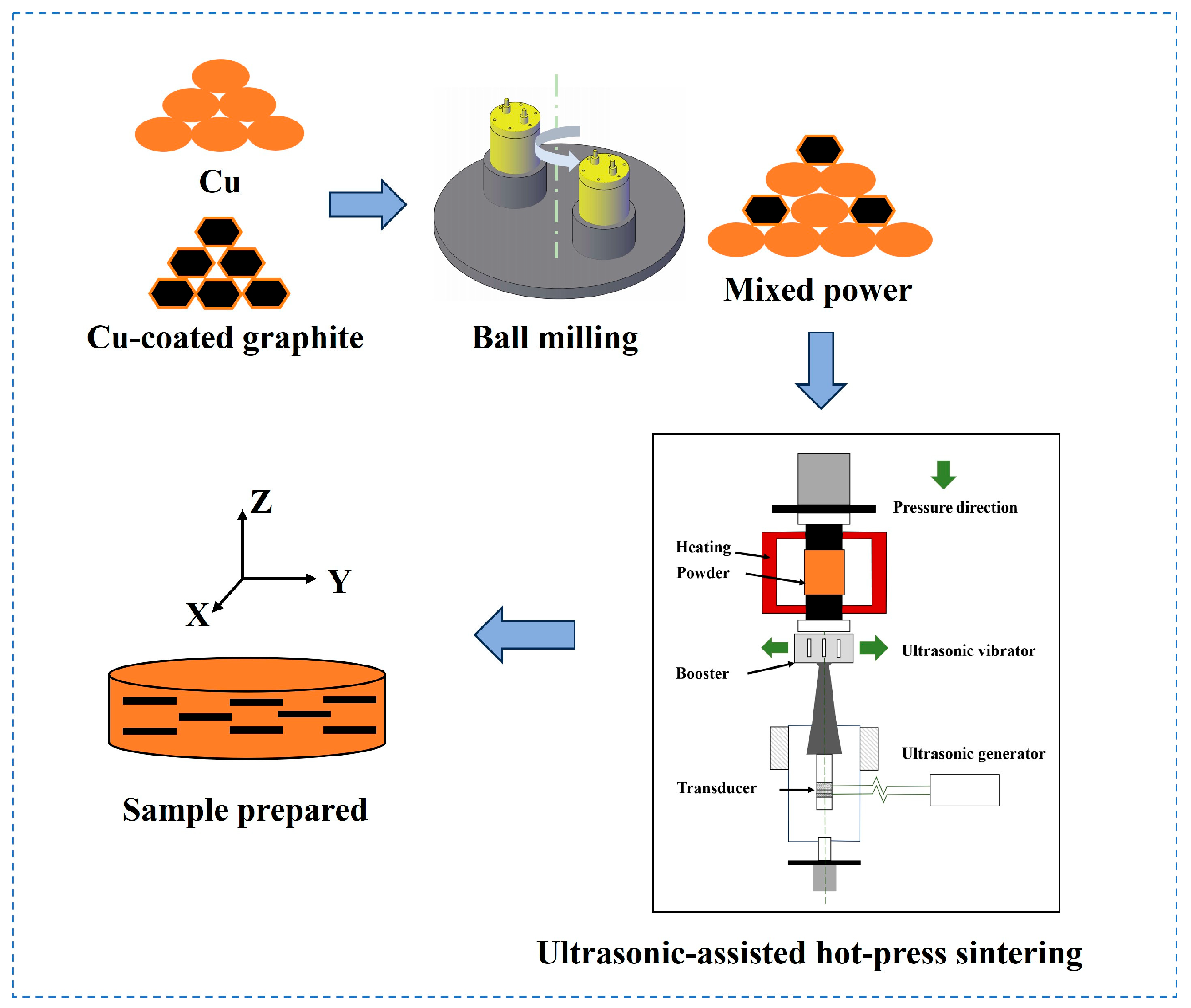
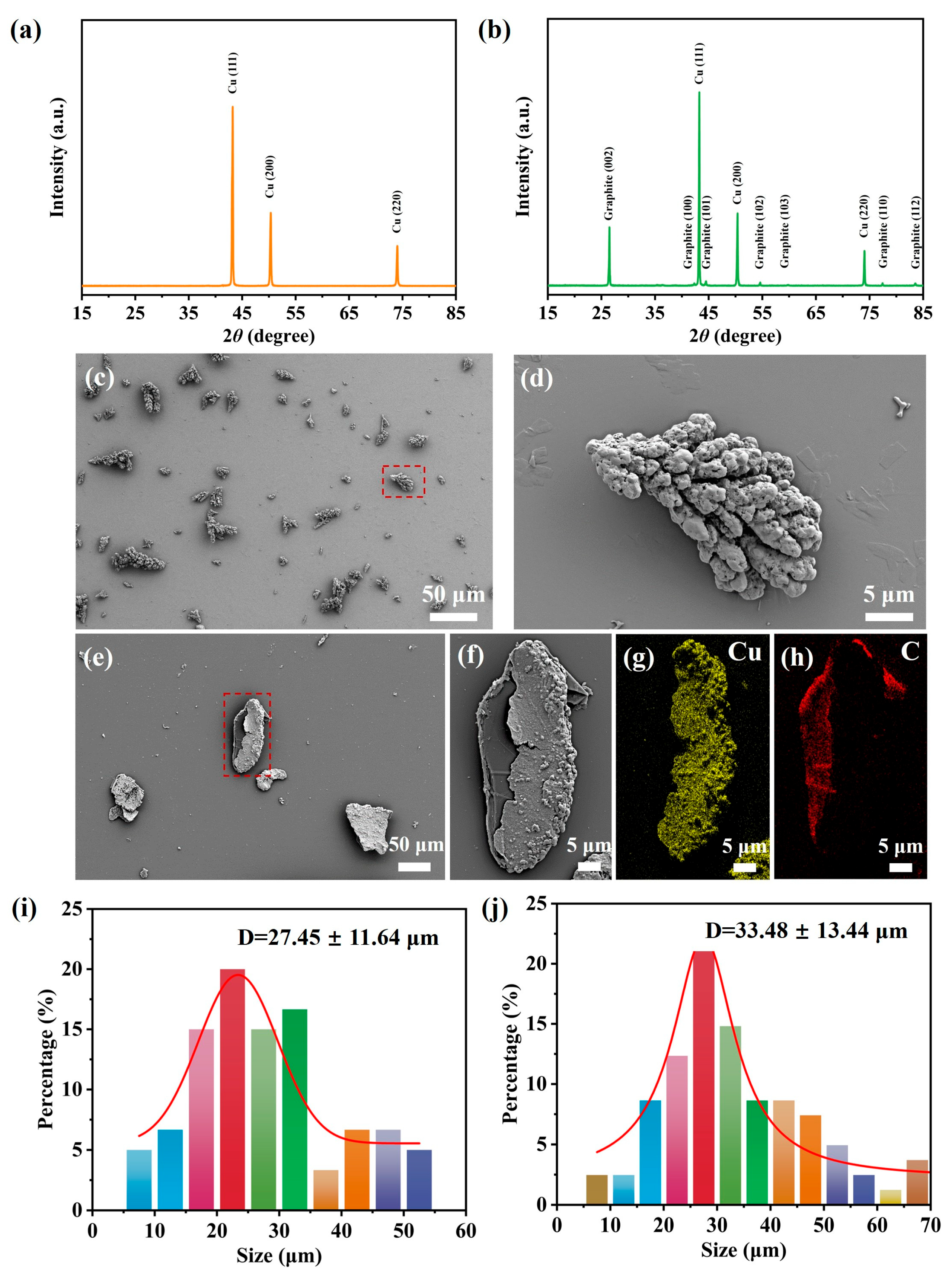


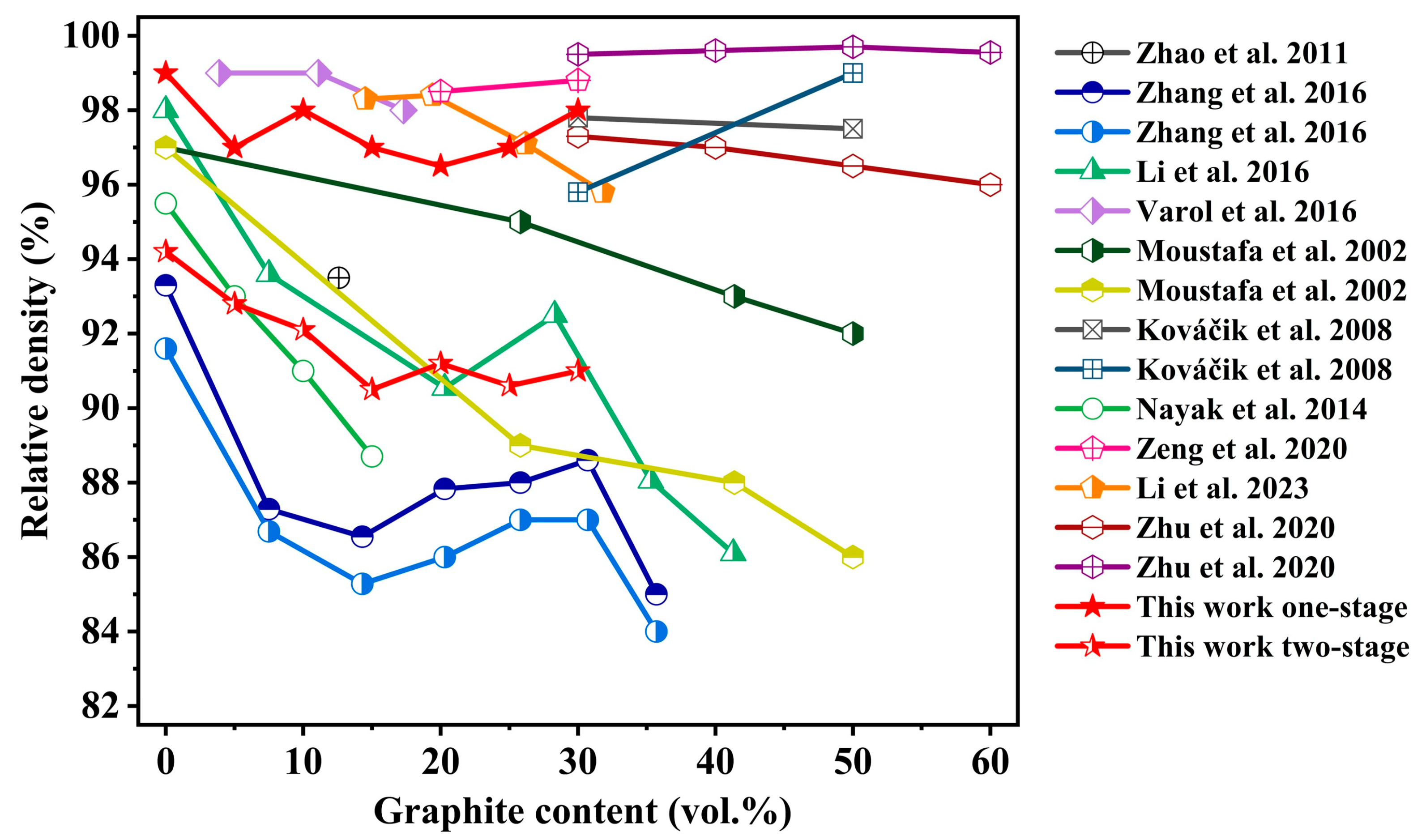
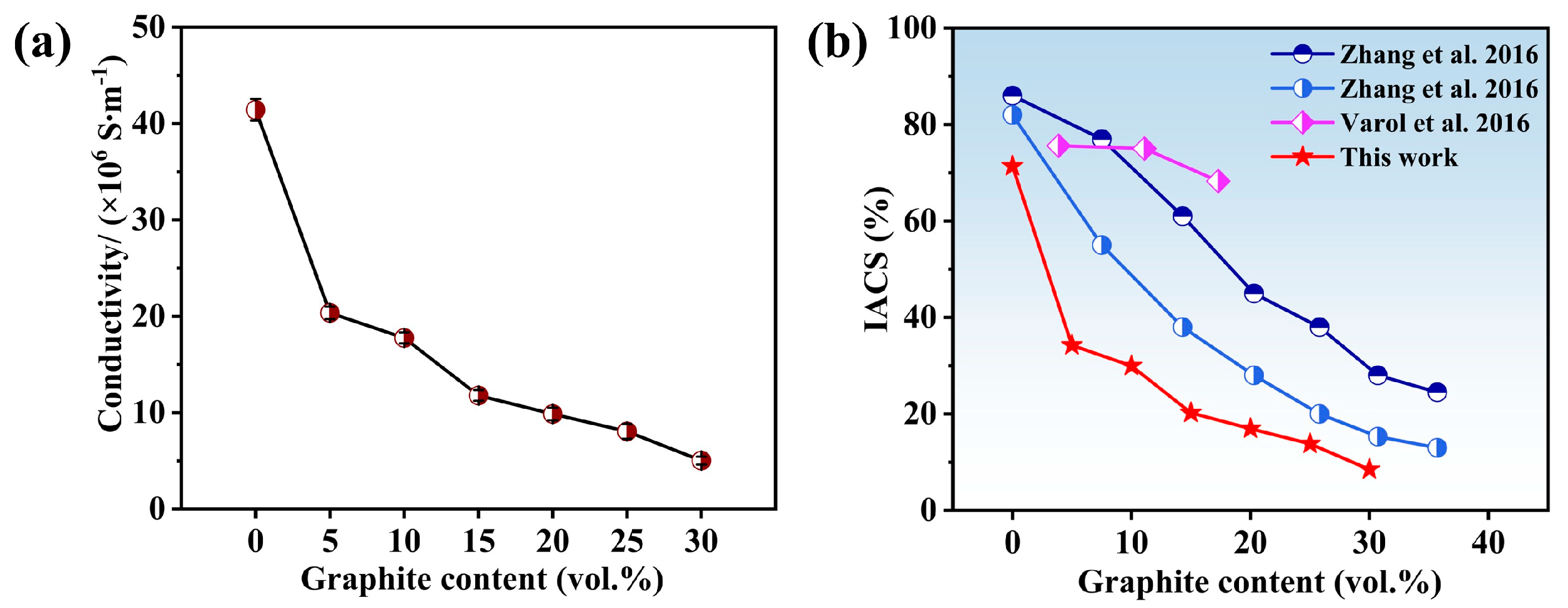
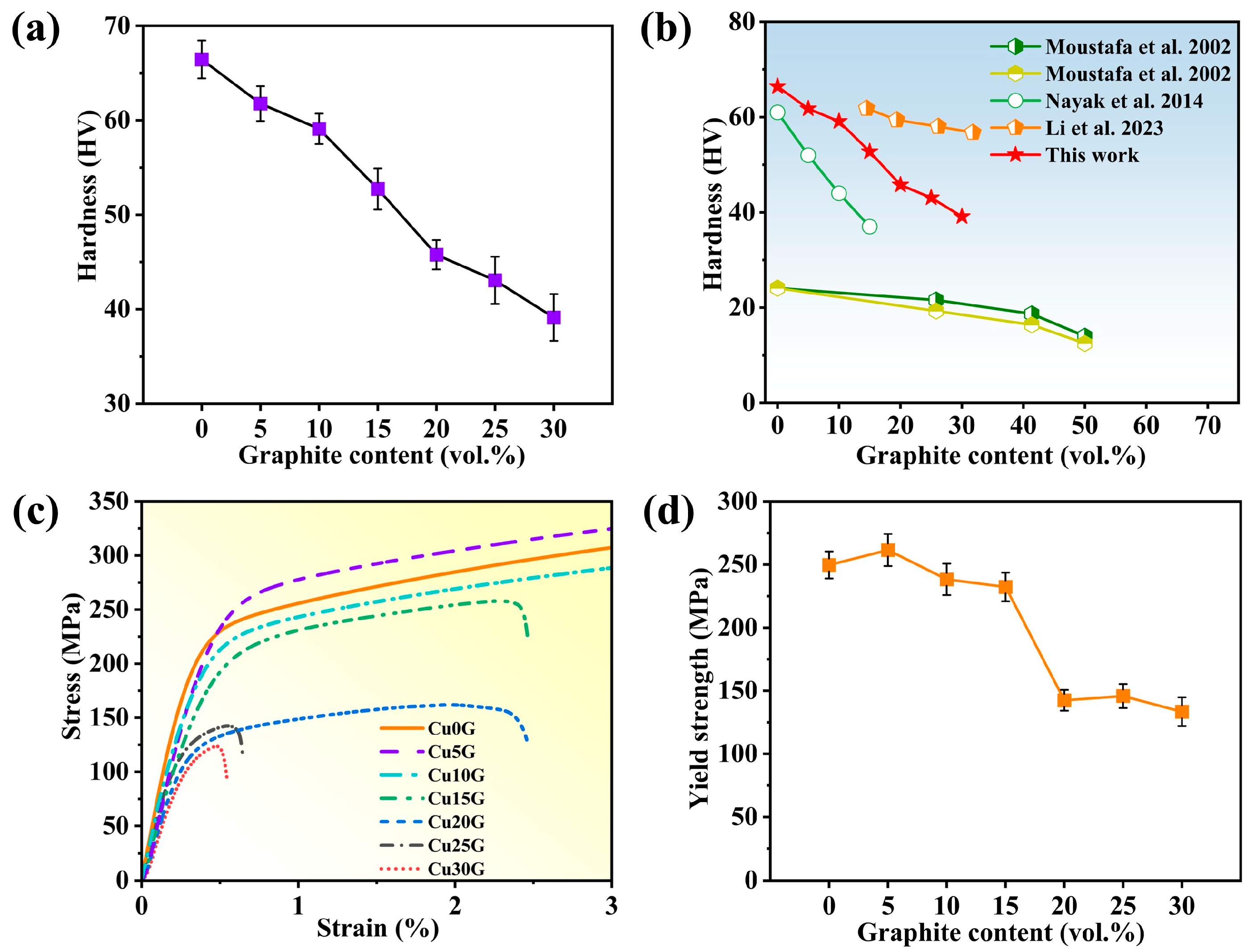


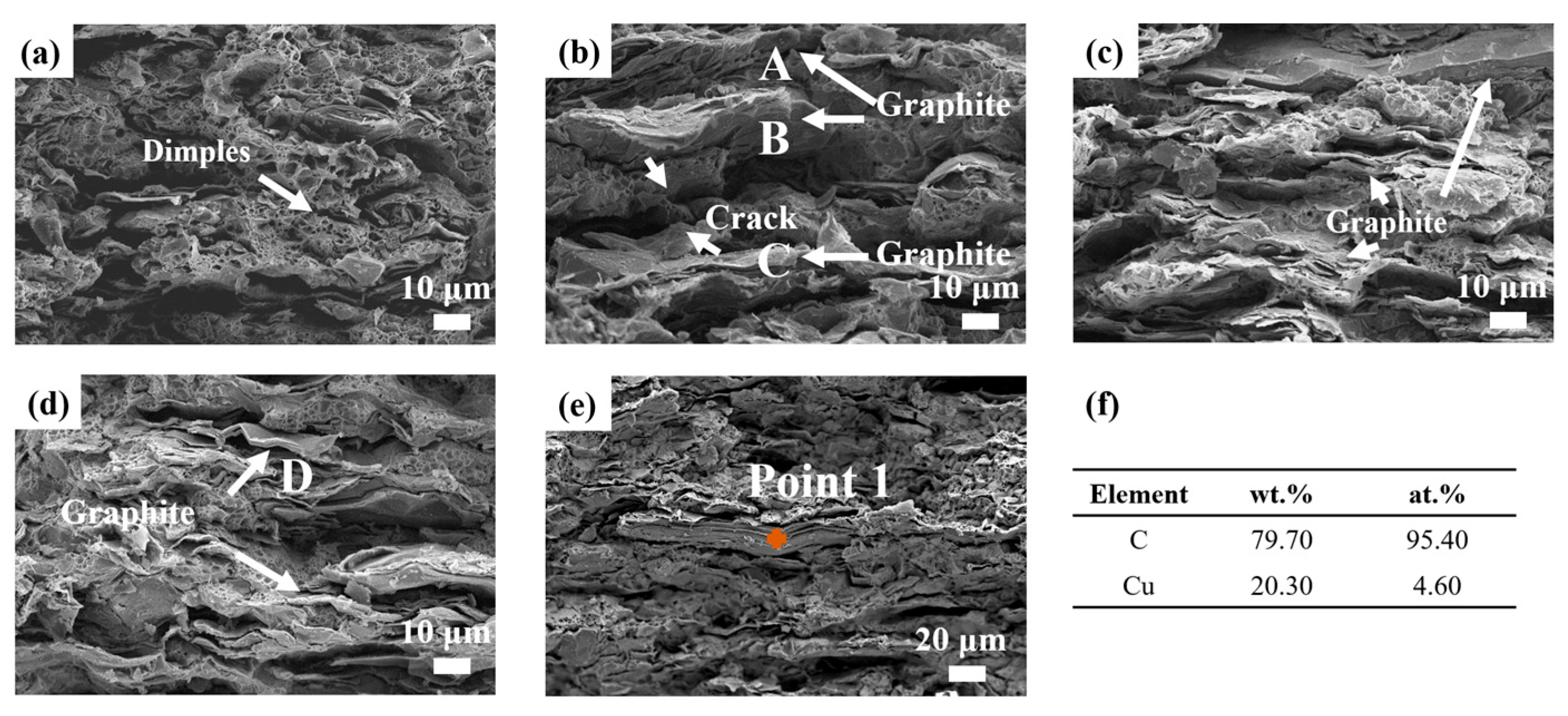
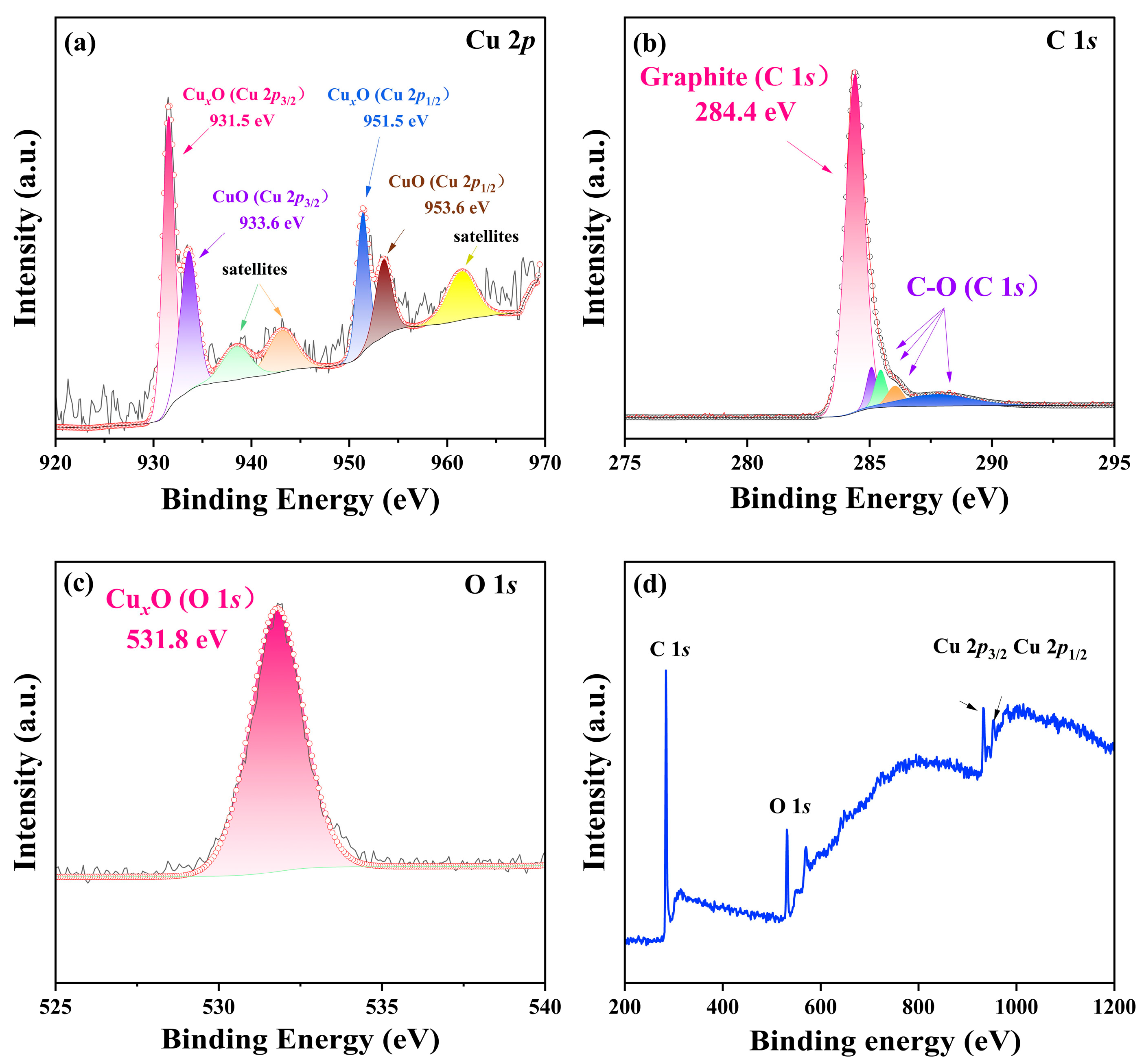
| Composition Code | Copper Content/vol.% | Graphite Content/vol.% |
|---|---|---|
| Cu0G | 100 | 0 |
| Cu5G | 95 | 5 |
| Cu10G | 90 | 10 |
| Cu15G | 85 | 15 |
| Cu20G | 80 | 20 |
| Cu25G | 75 | 25 |
| Cu30G | 70 | 30 |
| Material Composition | RD * (%) | Method | AT | T (°C) | t (h) | P (MPa) | Ref. | ||
|---|---|---|---|---|---|---|---|---|---|
| Cu + 9.2 vol.%Sn- 3.9 vol.%Cr- 3.1 vol.%Pb- 12.6 vol.% graphite | 93.5 | PL | H2 | 950 | 3 | - | [3] | ||
| Cu + 0–35.7 vol.% graphite | 93.3–85.0 | PL | Vacuum | 860 | 2 | - | [4] | ||
| Cu + 0–35.7 vol.% graphite | 91.6–84.0 | PL | Vacuum | 860 | 2 | - | [4] | ||
| Cu + 0–41.3 vol.% graphite | 98.0–86.1 | PL | Vacuum | 860 | 2 | - | [5] | ||
| Cu + 3.9–17.3 vol.% graphite (nano-graphite) | 99–98 | PL | Ar | 950 | 2 | - | [6] | ||
| Cu + 25.8–50.0 vol.% graphite (Cu-coated) | 95–92 | PL | H2 | 900 | - | - | [8] | ||
| Cu + 25.8–50.0 vol.% graphite (uncoated) | 89–86 | PL | H2 | 900 | - | - | [8] | ||
| Cu + 30.0–50.0 vol.% Graphite (Cu-coated) | 97.8–97.5 | HIP | Vacuum | 950 | 1.5 | 150 | [9] | ||
| Cu + 30.0–50.0 vol.% Graphite (Cu-uncoated) | 95.8–99.1 | HIP | Vacuum | 950 | 1.5 | 150 | [9] | ||
| Cu + 0–15 vol.% Graphite | 95.5–88.7 | PL | Vacuum | 1000 | 1 | - | [10] | ||
| Cu + 20.0–30.0 vol.% Graphite | 98.5–98.8 | HP | N2 | 1040 | 1 | 40 MPa | [20] | ||
| Cu + 14.5–31.8 vol.% Graphite (Cu-coated) | 98.3–95.8 | SPS | Ar | 860 | 0.5 | - | [23] | ||
| Cu + 30.0–60.0 vol.% Graphite | 97.3–96.0 | HP | Vacuum | 300 1 h-850 20 MPa 3 h- 950 50 MPa 1.5 h | [24] | ||||
| Cu2O + 30.0–60.0 vol.% Graphite | 99.50–99.55 | HP | Vacuum | 300 1 h-850 20 MPa 3 h- 950 50 MPa 1.5 h | [24] | ||||
| Cu + 0–30 vol.% Graphite (Cu-coated) | 99–98 | UAHP | Vacuum | 700 | 10 | 30 | This work, two-stage | ||
| Cu + 0–30 vol.% Graphite (Cu-coated) | 94–91 | UAHP | Vacuum | 700 | 10 | 30 | This work, single-stage | ||
| Graphite Content (vol.%) | Measured (GPa) | Calculated (GPa) |
|---|---|---|
| 0 | 62 | 112.2 |
| 5 | 52 | 100.3 |
| 10 | 50 | 90.4 |
| 15 | 47 | 82.0 |
| 20 | 43 | 74.7 |
| 25 | 45 | 68.3 |
| 30 | 39 | 62.5 |
| Graphite Content (vol.%) | Density (g/cm3) | IACS (%) | Vickers Hardness (HV) | Brinell Hardness Conversion Value (HBS) | Yield Strength (MPa) |
|---|---|---|---|---|---|
| 0 | 8.81 ± 0.05 | 71.36 | 66.43 ± 2.00 | 58.5 | 250 ± 11 |
| 5 | 8.31 ± 0.12 | 34.24 | 61.77 ± 1.85 | 55.0 | 262 ± 13 |
| 10 | 8.07 ± 0.06 | 29.98 | 59.10 ± 1.61 | 52.0 | 238 ± 12 |
| 15 | 7.66 ± 0.10 | 20.23 | 52.73 ± 2.18 | 46.5 | 232 ± 11 |
| 20 | 7.30 ± 0.15 | 16.96 | 45.77 ± 1.55 | 41.0 | 142 ± 8 |
| 25 | 7.01 ± 0.15 | 13.82 | 43.07 ± 2.50 | 40.0 | 146 ± 9 |
| 30 | 6.75 ± 0.18 | 8.51 | 39.13 ± 2.47 | 37.0 | 133 ± 11 |
| Element | Cu | C | Fe | Cr | O |
|---|---|---|---|---|---|
| at.% | 4.81 | 77.47 | 2.85 | 1.14 | 13.73 |
Disclaimer/Publisher’s Note: The statements, opinions and data contained in all publications are solely those of the individual author(s) and contributor(s) and not of MDPI and/or the editor(s). MDPI and/or the editor(s) disclaim responsibility for any injury to people or property resulting from any ideas, methods, instructions or products referred to in the content. |
© 2025 by the authors. Licensee MDPI, Basel, Switzerland. This article is an open access article distributed under the terms and conditions of the Creative Commons Attribution (CC BY) license (https://creativecommons.org/licenses/by/4.0/).
Share and Cite
Zhou, S.; Zhang, S.; Xiang, H.; Xu, W.; Sun, K.; Fang, C.; Xie, W.; Wang, H.; Zhou, Y. Ultrasonic-Assisted Hot-Press Sintering: A Novel Method to Reduce the Densification Temperature and Enhance the Mechanical and Tribological Properties of Cu–Graphite Composites. Lubricants 2025, 13, 366. https://doi.org/10.3390/lubricants13080366
Zhou S, Zhang S, Xiang H, Xu W, Sun K, Fang C, Xie W, Wang H, Zhou Y. Ultrasonic-Assisted Hot-Press Sintering: A Novel Method to Reduce the Densification Temperature and Enhance the Mechanical and Tribological Properties of Cu–Graphite Composites. Lubricants. 2025; 13(8):366. https://doi.org/10.3390/lubricants13080366
Chicago/Turabian StyleZhou, Shijia, Shuang Zhang, Huimin Xiang, Wei Xu, Kuang Sun, Cheng Fang, Wei Xie, Hailong Wang, and Yanchun Zhou. 2025. "Ultrasonic-Assisted Hot-Press Sintering: A Novel Method to Reduce the Densification Temperature and Enhance the Mechanical and Tribological Properties of Cu–Graphite Composites" Lubricants 13, no. 8: 366. https://doi.org/10.3390/lubricants13080366
APA StyleZhou, S., Zhang, S., Xiang, H., Xu, W., Sun, K., Fang, C., Xie, W., Wang, H., & Zhou, Y. (2025). Ultrasonic-Assisted Hot-Press Sintering: A Novel Method to Reduce the Densification Temperature and Enhance the Mechanical and Tribological Properties of Cu–Graphite Composites. Lubricants, 13(8), 366. https://doi.org/10.3390/lubricants13080366






